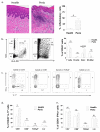Characterization of the human immune cell network at the gingival barrier
- PMID: 26732676
- PMCID: PMC4820049
- DOI: 10.1038/mi.2015.136
Characterization of the human immune cell network at the gingival barrier
Abstract
The oral mucosa is a barrier site constantly exposed to rich and diverse commensal microbial communities, yet little is known of the immune cell network maintaining immune homeostasis at this interface. We have performed a detailed characterization of the immune cell subsets of the oral cavity in a large cohort of healthy subjects. We focused our characterization on the gingival interface, a particularly vulnerable mucosal site, with thin epithelial lining and constant exposure to the tooth adherent biofilm. In health, we find a predominance of T cells, minimal B cells, a large presence of granulocytes/neutrophils, a sophisticated network of professional antigen-presenting cells (APCs), and a small population of innate lymphoid cells (ILCs) policing the gingival barrier. We further characterize cellular subtypes in health and interrogate shifts in immune cell populations in the common oral inflammatory disease periodontitis. In disease, we document an increase in neutrophils and an upregulation of interleukin-17 (IL-17) responses. We identify the main source of IL-17 in health and Periodontitis within the CD4(+) T-cell compartment. Collectively, our studies provide a first view of the landscape of physiologic oral immunity and serve as a baseline for the characterization of local immunopathology.
Figures





References
-
- Winning TA, Townsend GC. Oral mucosal embryology and histology. Clin Dermatol. 2000;18:499–511. - PubMed
Publication types
MeSH terms
Substances
Grants and funding
LinkOut - more resources
Full Text Sources
Other Literature Sources
Research Materials
Miscellaneous

